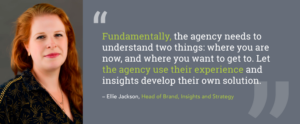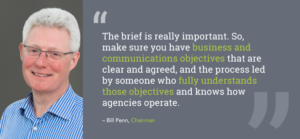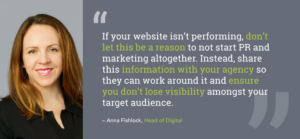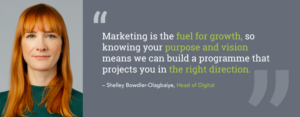How to write a brief for a brand and marketing agency

By Ellie Jackson, Head of Brand, Insights and Strategy
Nothing has made me question my ability to write a brief like having small children.
Bear with me here. I’m not for one second comparing the recipients of briefs I write to my 1- and 4- year-old offspring. But where once I thought I was pretty clear in my translation of objectives, clarity of direction and indication of priorities, scenes in our house in the hour before nursery and school drop off suggest otherwise.
And writing a brief for a brand, marketing and communications agency is rather more complicated than getting small people clothed, fed, brushed, shod and out. But the real trouble, as highlighted in research last year as part of the Better Briefs project, is the divergence between those marketers that think they write good briefs (80%), and the creative agencies that receive them (10%).
Historically one of our best-performing pieces of content was a post about how to write a good brief, but since it’s more than a decade old we thought it was well-overdue for a review, and since I recognize my own limitations, I’ve enlisted various colleagues representing different Aspectus services to offer up their insights in addition to mine.

Fundamentally though, the agency needs to understand two things: where you are now, and where you want to get to. But it’s also really useful to understand what you’ve tried before, what’s worked and what hasn’t. Most of all, we appreciate a relatively open brief: tell us the problem and by all means suggest your response, but don’t lock us into rigid tactics. Let the agency use their experience and insights develop their own solution.
Bill Penn, Aspectus Chairman, added: “The brief is really important. So, make sure you have business and communications objectives that are clear and agreed, and led by someone who fully understands those objectives and knows how agencies operate.
“Be targeted. Even if your product or service could be used by several different audiences, you still need to focus to see results. Most agencies will push you to prioritise, so you need to work out your strategy internally in advance.

“You will need to ring-fence a budget. Agencies hate briefs without clear budgets and you will never get the best from their pitches if you leave the matter completely open-ended. It’s a bit like walking into a showroom and telling the sales guy you want to buy a car and letting him guess how much you want to spend. Not awfully helpful to either of you. Are you after a Ferrari or a Mini?
“Invite all agencies for an initial meeting or call. This gives you a chance to meet them and they get the opportunity to discuss the brief in more detail and ask questions.
“Work out in advance a system for assessing the presentations – and keep those presentations to a maximum of three agencies. Think in terms of focusing on the following: capabilities and experience; quality of ideas; quality of team; enthusiasm; response to questions. Be clear with the agencies on both the process and the decision factors.
“Once you have made your decision, tell the winning agency first (just in case they find a reason why they cannot or don’t want to work with you – it does happen) and then inform the others. Do make sure that you give plenty of feedback to the losing agencies. The very least they deserve for all their hard work is the opportunity to know where they went wrong or simply why the winning agency was selected.”
Ed Wilkins, Head of Design and UX, said: “Brand guidelines are a hugely valuable asset, but it’s essential to communicate your relationship with them to avoid unhelpful assumptions being made. This works both ways. There have been many a time where a client has wondered why we’ve shown creative flair when all they wanted is something very close to the examples already included, and others where the guidelines were meant to be a mere suggestion. Even being surprised at the inclusion of their own colours.”

“Never be afraid to share something you’ve seen and liked. It’s easy to worry that your agency will only replicate a shared example, but these are one of the best ways for designers to understand your thinking. They spark more in-depth initial conversations around your likes, dislikes and why you feel that way. It should also then allow your agency to give some early indications of how ideas can be reinvented to suit the project at hand before putting pen to paper. This means a much more effective use of your scoped design time.”
Anna Fishlock, co-head of Digital, added: “It’s often helpful for agencies to know key website stats, for example, top-performing pages, where your traffic tends to come from, and your bounce rate. With this information we can usually get a good understanding of the health of your website. Also, don’t forget to share your SEO keywords or let the agency know if this is an area where you might need additional support.

“If your website isn’t performing, don’t let this be a reason to not start PR and marketing altogether. With new B2B website projects often taking several months to complete, you’ll lose vital brand awareness if you stop running campaigns. Instead share this information with your agency so they can work around it and ensure you don’t lose visibility amongst your target audience.”
Shelley Bowdler-Olagbaiye, co-head of Digital, said: “We always want to know the bigger picture: what are your marketing objectives, overarching business goals and why are you looking for an agency now? Marketing is the fuel for growth, so knowing your purpose and vision means we can build a programme that projects you in the right direction.
“Writing a great agency brief is an art in itself, so talk us through your challenges and we can help you find the best digital and integrated solutions. The best client agency-relationships are collaborative – and for us, that starts from the first conversation.”

Related News
-

Getting AI to train your spokespeople
June 27, 2025 -

25 years of TradeTech – the good, the bad and the road ahead
May 19, 2025